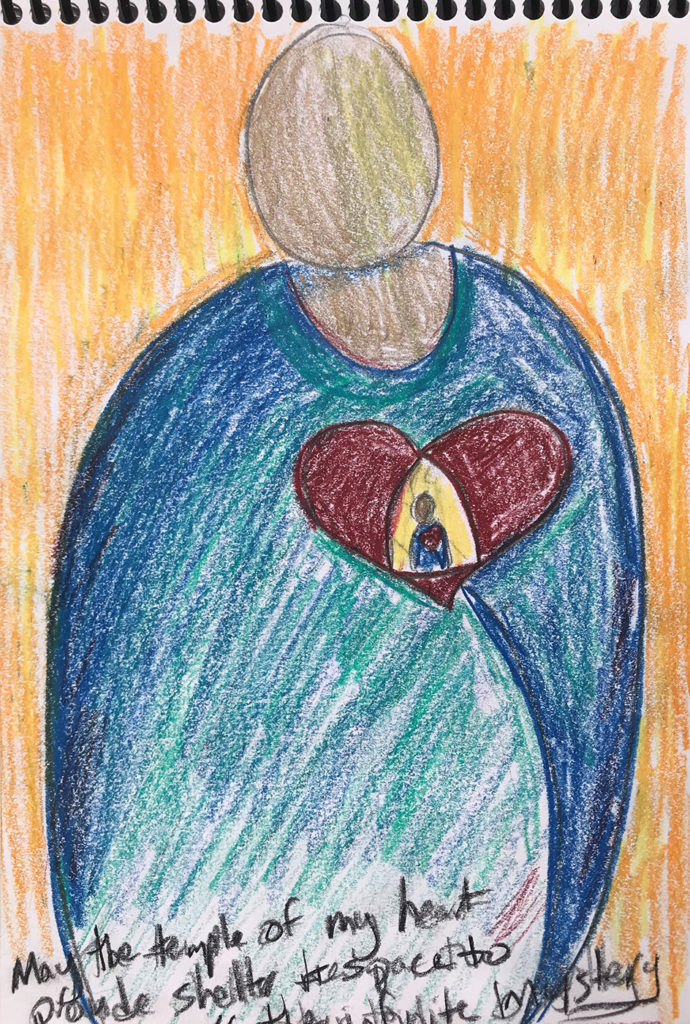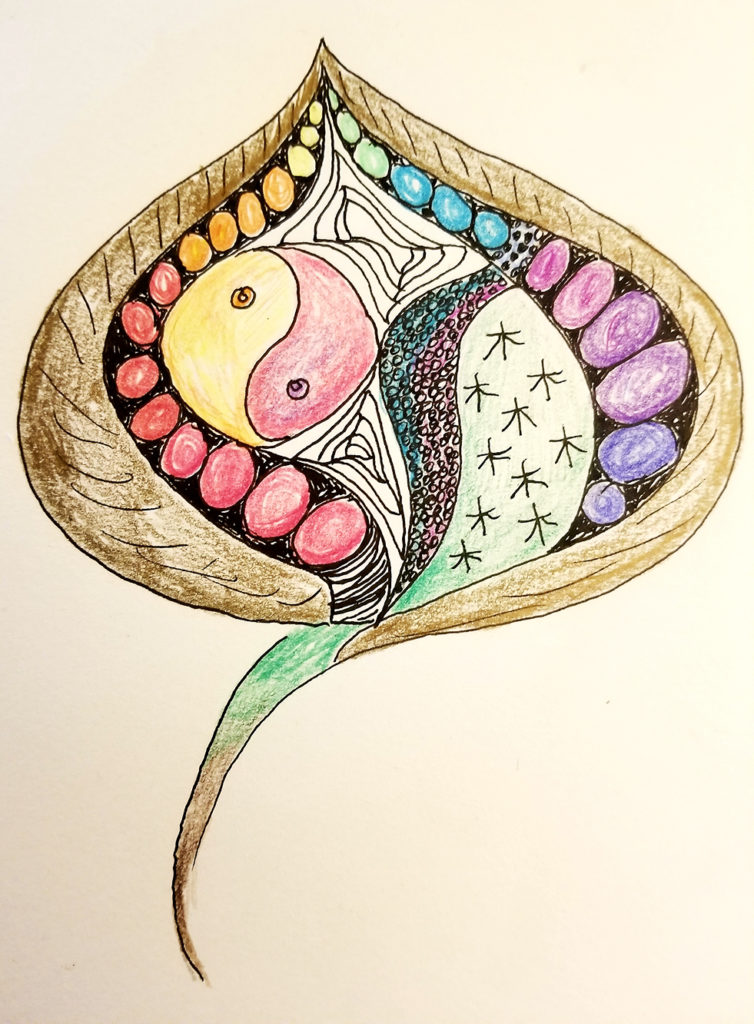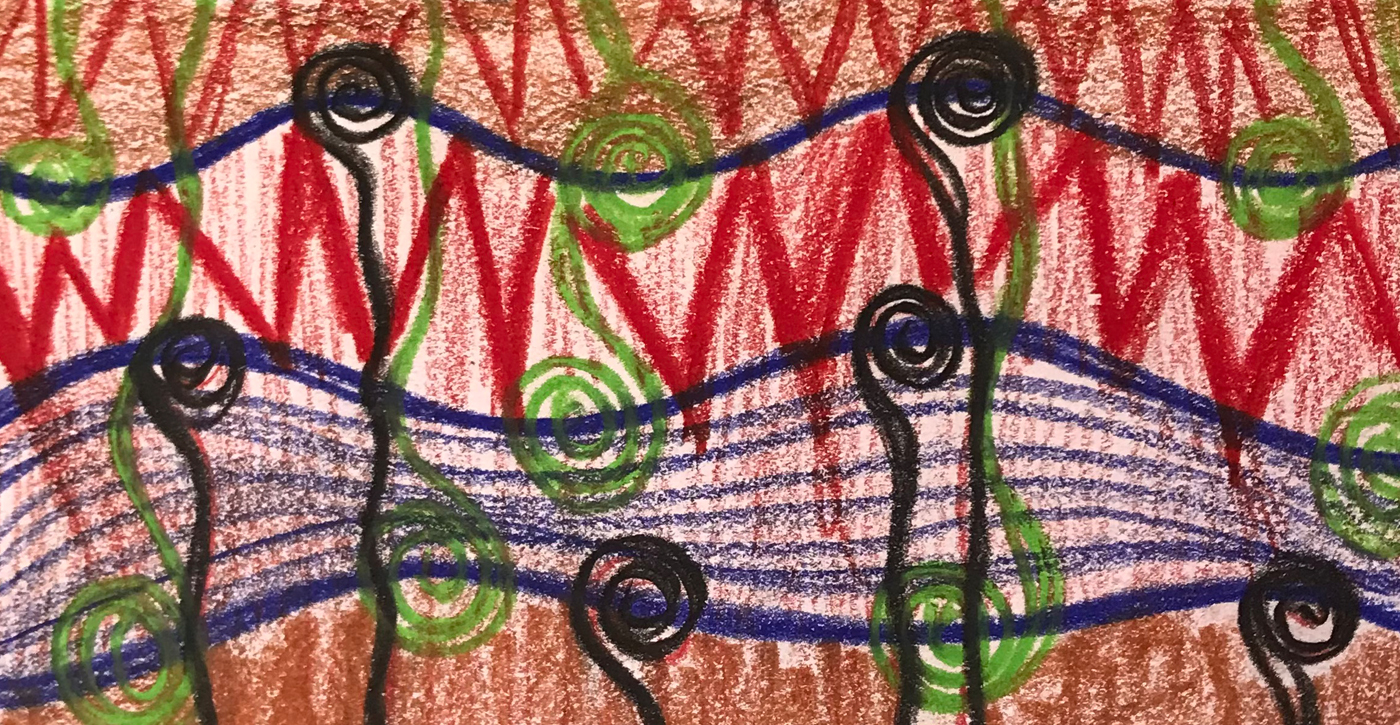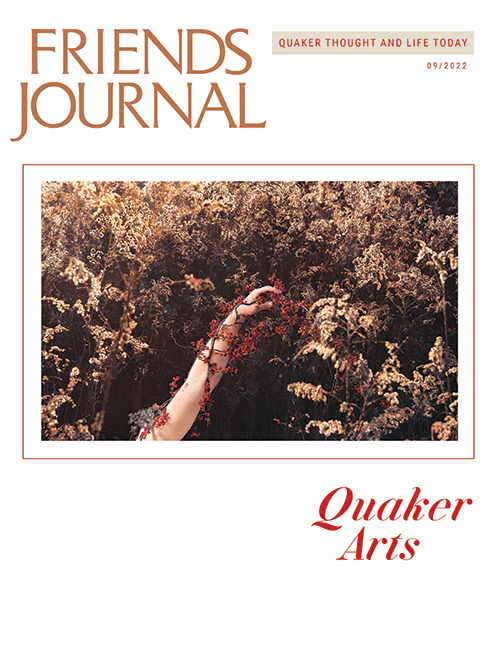It was the acute phase of the early pandemic, and many of us were longing for connection, community, and a way through. I was in a pod of one, grieving the loss of a couple of family members to whom I could not travel to say goodbye, and in a new town where I didn’t know anyone. Our healthcare facilities were overwhelmed with COVID cases and deaths. As a country, we were stretched thin.
I needed a community and a way to help me process what I was going through. Following Spirit’s leading, I developed an online group for art journaling as a spiritual practice, a format I call heART Journaling. Over the past two years, this practice has developed and grown into both a weekly offering and a format to explore racial justice. I have found Spirit can move through a collective art journaling process, much like when we are gathered for Quaker worship.

“May the temple of my heart provide shelter & space to know the infinite mystery” heART Journaling prayer by LJ Boswell.
heART Journaling
I offered the first experimental sessions through Beacon Hill Friends House in Boston, Massachusetts, in the fall of 2020. Many of the participants expressed surprise at how different it was from other Zoom-led spiritual offerings. They consistently mentioned how the experience left them feeling renewed, uplifted, and connected to one another. To date, I’ve facilitated heARt Journaling for over 50 drop-in sessions in a variety of settings, including Beacon Hill Friends House; Green Street Meeting in Philadelphia, Pennsylvania; Framingham (Mass.) Meeting; Ohio Valley Yearly Meeting; a local nonprofit, which serves trauma survivors; and as a guest presenter in an antiracist workshop series.
Drawing on our Quaker faith and practice, heART Journaling offers individuals time to reflect on their own lives and provides the group time to worship share. Each session begins with an art warm-up for participants to become comfortable with being creative in a group setting. Then participants are invited into a guided meditation on their experiences during the previous week. This is followed by ample time to art journal to the accompaniment of acoustic music.
Once the first round of journaling is complete, participants worship share by holding up their drawing and/or verbally reflecting on their process as they are led. Worshipful silence during, between, and after each sharing, allows for each person to feel deeply witnessed and held. After a second round of journaling, we end with worship sharing about our prayers, intentions, and hopes for the coming week. Each individual’s prayer or intention is collectively met with a chorus of “May it be so!”
After participating in a couple of the initial drop-in sessions, Lola Georg of Green Street Meeting in Philadelphia, suggested to her meeting’s Care and Counsel Committee that the meeting offer heART Journaling through the early winter months of 2021. Lola recalls:
We thought it would be a difficult time for Friends who lived alone or were otherwise isolated. And so, we undertook a ten-week art journaling adventure to offer people a way to connect outside of meeting for worship during a time when the lack of social connection was a strain on many. . . . The participants were very grateful to LJ for their skill in coaxing us along each week, as we delved into new techniques and discovered new insights.

Seed/Womb heART Journaling reflection by Barb Rice.
Worship with Attention to Drawing
“I come every week for worship with attention to drawing,” explains Barb Rice, of Madison (Wisc.) Meeting in Northern Yearly Meeting:
I’ve learned that my hand knows what my mind doesn’t sometimes. I let my hand do with pencils what my voice does when I feel moved to speak in worship. And I end up with something I can look at throughout the week!
Because heART Journaling is not about creating a beautiful piece of art but about focusing on the process of art making as a spiritual practice, those who are not artists quickly learn to focus on creation as a method of reflection. Donna Hawkins, a regular participant, explains:
None of my other art groups bring me to this introspection. I wish I were more artistic and not so literal, but LJ helps us move past the need to critique our work. The story is the message.
“The mini art lessons each week helped us to explore textures, patterns, distance, shading, and perspective in various ways,” explains Lola Georg.
I could see, over time, how they expanded my overall repertoire of techniques so that new expressions of my spiritual condition could emerge.
For Lola, the entire process was very helpful for revealing “inner truths that were bubbling just under the surface.”
Similarly, Gail Melix, of Sandwich (Mass.) Meeting finds heART Journaling to be:
a whole new way to open to relationship with myself and Spirit. Exploring the ways in which truth and love guide me on a deeper level was both freeing and affirmative. And joyful. When we take what we are feeling into a creative space something magical/mystical evolves.
“It’s amazing that this works on Zoom,” reflects Monica Biswas:
It honors each person’s journey as its own thing while also inviting everyone to feel connected to the collective experience. Saying “May it be so” to each individual as they share their hope, intention, or prayer at the end of the session is a beautiful and simple way to honor both the individual and the collective.
Examples of First Round Drawings during one session of heART Journaling. Left: Illustrating grief and frustration of how people with power stay isolated in their tower and nothing changes after another mass shooting. By Donna Hawkins. (top); The mist of the waterfall touches all of us and everything by S[tephanie]ann. (bottom). Right: Allowing the pain to seep downward, the earth filters, nurturing new growth by LJ Boswell.
Sometimes Gathered
St[ephanie]ann, another regular participant, comes to heART journaling
because I need it. HeART journaling nourishes something inside me that I have difficulty connecting with on my own. As a disabled artist, musician, and poet, it’s easy for me to isolate. HeART journaling allows me to tap into the magic of the everyday. I don’t mean rabbit-in-a-hat, sleight-of-hand magic. I mean the kind of magic that can only be experienced in a safe, co-created space.
The power of witnessing one another is a significant part of the magic of heARt Journaling. Says Liz Thompson:
The sheer beauty of seeing how someone creates and describes their experience in such a non-judgmental and vulnerable state creates compassion in me. Then I can feel some of that towards myself.
Liz has participated in dozens of sessions. She really appreciates “hearing others say my truth in words I can’t quite articulate. It’s the Zeitgeist we are all experiencing in similar ways.”
In Quaker terms, this magic and beauty are parallel to a gathered meeting where everyone deeply feels the spiritual connection to the whole. Barb Rice explains, “Sometimes our drawings relate to each other as though we are in a gathered meeting.”
No matter how often this occurs, I find myself in awe of how the heART Journaling format allows for this sort of gathering to build. The guided meditation invites participants to reflect on the larger events of their week that took focused energy, the small rhythms and patterns of their days, and the condition of the world and how it’s impacting them.
When sharing our first round of drawings, we often are amazed at how themes emerge in each other’s drawings. For example, one time a few of us drew fire, representing different aspects of passion and release. Another time, everyone’s first round drawing had some representation of flow and pain: a river with rocks; a curvy abstract flow with a jagged, gray geometric pattern underneath it; a sun reaching down to touch a red, red ball. This is Spirit moving through us collectively.
Because we have witnessed each other’s first-round drawings, sometimes messages emerging in the second round unify and speak to each other. For example, in a first round of sharing, St[ephanie]ann, Donna, and I respectively drew: a waterfall with the mist that touches all; an image of a mass shooting that had just occurred and a raining down of tears from the sky, with a tower that remained separate from it all; and an abstract filter that processed and removed the pain of the world.
The gathering or mystical magic happened in the second round during which we drew our hopes, prayers, and/or intentions. Donna drew the tower in ruins, guns having been banned, and the folks no longer in the tower but on the ground, in community with others under a large rainbow. I drew the waterfall moving through the tower, filtering out the isolation with the mist touching all. I then drew two large rainbow bridges out of the tower with the words
May they also be touched. May there be bridges into the flow of change and transformation. May the rigidness in myself and others soften.
There is a quickening of the heart when different people’s drawings share images and messages. Everyone seems to inhale deeply in recognition of the gathering of Spirit moving through us. “Watching our art reflect our community and how we process our challenges is the kind of magic I need in these times.” St[ephanie]ann explains.
Every time I attend a session, I am reminded of the importance of community. Sometimes life feels like just a series of never-ending meetings and surface-level niceties. In heART Journaling, the only requirement is to show up. It doesn’t feel like an obligation. I’m reminded that my presence in a community is welcomed; encouraged; and in fact, necessary.
Our images informed each others in the second round of drawing. Left: Envisioning a future where the mist touches all, filtering out the separation, so that we can soften and transform. By LJ Boswell. Right: Envisioning a future where gun control is achieved by Donna Hawkins.
Exploring Race with heART
In addition to the isolation and grief of the pandemic, over the past two years many White people have been waking up to the reality of racial injustice in our country and experiencing grief with this realization. As a White person who has studied and taught about power, privilege, and race for decades, and as an interfaith chaplain who knows how to hold and honor grief, I felt led to offer a format for both White and BIPOC people to process their relationship to race and racial justice.
The result was a modified version of heART Journaling called heART-filled Racial Justice. Instead of reflecting on one’s week, the guided meditations invite an open-hearted curiosity about one’s relationship with race and racial justice. For example, participants were invited to journal about the first time they realized that race existed, about their ancestral family relationship to race, etc.
Sheila Garrett of Putney (Vt.) Meeting reflects that participating in heART-filled Racial Justice means
overcoming self-consciousness and nervousness that almost inevitably accompanies participating in a class or group, and developing enough trust to be vulnerable. LJ brought their own vulnerability into the process, modeling a level of creating and sharing that encouraged us all. They know how to personalize and acknowledge the discomfort, not denying or trivializing but moving with and through whatever comes up.
Fran Brokaw, a member of Hanover (N.H.) Meeting, explains heART Journaling about race
was really a different way of exploring the deep feelings of being a White person who unjustly benefits from a culture that has been set up to privilege me and to remove privileges from people who are different from me. It’s really working many of the lessons that I’ve already heard but maybe not as deeply internalized. Having LJ use their noticing was very helpful both when they offered me feedback and offered it to other folks. LJ does it in a very gentle, caring way that’s not at all scary or anything like that.
“Even if it makes you uncomfortable, it’s really important to instill forms of critical self-reflection into your life,” encourages Danielle Pappo, one of the participants in my initial pilot.
Richard Lindo, of Framingham (Mass.) Meeting, reflects that heaRT-filled Racial Justice “provided an opening to a deeper, richer experience of something that felt more eternal and, in that way, felt transformational.”
“Many New England Quakers, including myself, tend to ‘live in our heads’ and to use that knowledge as a shield to protect ourselves from spiritual immediacy,” explains Julie Heagney of Framingham (Mass.) Meeting.
Sitting in LJ’s workshop, using large, colored markers in a clumsy way to describe my family’s close connection to slavery and where I fit into that history was a raw expression of reality that is difficult for me to put into words.
Julie can now
better appreciate and feel those special moments in my past when my mother hugged her childhood nanny but did not ask her to sit down in the house; when the little daughter of my Sudanese friends placed her perfect satin brown arm next to mine and asked, “When will it turn white?” or when I first saw my tiny Salvadoran son, whom I was adopting, holding hands with his little friend and looking down, as though the moment was not happening. These memories bring tears even now, and I hope they will cleanse a small part of the open wound of racism and begin to heal the world.
In part, this is grief work. Drawing and sharing our drawings provides for a different kind of release than talking or writing. Every time we share some of our pain with others, we heal a little.
Fran recalls
the grief that I felt when I first saw and really internalized the reality of how I had been lied to all my life, is really painful and sad. Recognizing this as a loss is really important for anybody doing racial justice work with other White people. It allows the practitioner to feel and display compassion. LJ clearly has a lot of compassion for everyone that they meet.
Recently Monica Biswas, founder of and antiracist consultant for Accidental Perfectionist, invited me to lead a closing reflection for one of her programs using heART-filled Racial Justice methods. Monica explains:
as a facilitator of conversations about antiracism, it’s easy to minimize the amount of time allotted for reflection and synthesis. This simple and elegant process met people where they were and provided such a feeling of spaciousness that it loosened our ability to get in touch with and share feelings of discomfort, shame, guilt. The process is beautiful, beyond anything I could have expected.
Changing Our Stories
In addressing some of the isolation and overwhelming feelings during the early pandemic, I discovered a way to use art as a tool for reflection that collectively moves us beyond words into our heart center. [H]eARt Journaling and heART-filled Racial Justice both gently invite us to reflect deeply on our lives and by doing so, change our stories.
We can release the stories of isolation, of power-over, of scarcity. We can release shame, guilt, fear, and powerlessness that may arise when we think of ourselves simply as individuals. By collectively reflecting with heART, we experience that we are not actually alone but deeply and mystically interconnected.
Each one of our individual stories is part of the whole. There’s such a relief and power in this.
Whether in our personal lives, in moving towards racial justice, or in reflecting on how the two intersect, we cannot change what we cannot see or name. Art literally provides a vehicle to express dynamics that otherwise can be challenging to name. Through the making and sharing of art, we can change our stories.










Thank you for this 🖼 cle on Art 📓 ng. It is a practice of mine as well, with a few only ne friends who are interested in expressive arts ( we studied it together at University of South Florida in a graduate certified ficate program. When I tried to introduce ce it to a midwest congregation I was padtoring, they thought I was just weird. This is so affirmative ng for me
I’m so glad this article was affirming for you. I found an important part of the process for getting non- artists comfortable with expressing themselves creatively is the art warm up time. I looked at shortening the process by cutting this portion and participants replied with how essential it was for them.
You’d be welcome to join us and check out how it works in person. Right now, I’m offering weekly drop-in heART Journaling weekly sessions on Tuesdays 7-8:30pm ET. There’s more information and a registration form on my website: https://www.spiritheals.me/upcoming-events